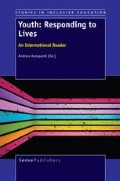Abstract
The David Livingstone Museum in Livingstone, Zambia contains within its walls a microcosmic representation of Zambian history, culture, and society. As the museum patron walks through the exhibits, time advances.
Access this chapter
Tax calculation will be finalised at checkout
Purchases are for personal use only
Preview
Unable to display preview. Download preview PDF.
References
Apple, M. W. (2004). Creating difference: Neo-liberalism, neo-conservatism and the politics of educational reform. Educational Policy, 18(1), 12-44.
Bourdieu, P., & Passeron, J-C. (1977/1990). Reproduction in education, society and culture (2nd ed., R. Nice, Trans.). Thousand Oaks, CA: Sage.
Campbell, F.K. (2005). Legislating disability: Negative ontologies and the governance of legal identities. In S. Tremain (Ed.), Foucault and the government of disability (pp. 108-132). Ann Arbor, MI: University of Michigan Press.
Cohen, Y. A. (2000). The shaping of men’s minds: Adaptations to imperatives of culture. In B. A. U. Levinson (Ed.), Schooling the symbolic animal: Social and cultural dimensions of education (pp. 83-107). Lanham, MD: Rowman & Littlefield. (Original work published 1971.)
Cusick, P. (1973). Inside high school: The students’ world. New York: Holt, Rinehart & Winstone.
Davis, L. J. (1995). Enforcing normalcy: Disability, deafness, and the body. New York: Verso.
Demerath, P. (2009). Producing success: The culture of personal advancement in an American high school. Chicago: University of Chicago.
Durkheim, E. (2000). The nature of education. In B. A. U. Levinson (Ed.), Schooling the symbolic animal: Social and cultural dimensions of education (pp. 57-61). Lanham, MD: Rowman & Littlefield. (Original work published 1956.)
Fordham, S., & Ogbu, J. U. (1986). Black students’ school success: Coping with the “burden of ‘acting white.’” The Urban Review, 18(3), 176-206.
Foucault, M. (2006). History of madness (J. Khalfa, Ed., J. Murphy & J. Khalfa, Trans.). London: Routledge.
Fukuyama, F. (1992). The end of history and the last man. New York: Avon Books.
Fuller, B. (1991). Growing-up modern: The western state builds third-world schools. New York: Routledge.
Groce, N. E. (1985). Everyone here spoke sign language: Hereditary deafness on Martha’s Vineyard. Cambridge, MA: Harvard University Press.
Henry, J. (2000). Education and the human condition. In B. A. U. Levinson (Ed.), Schooling the symbolic animal: Social and cultural dimensions of education (pp. 53-61). Lanham, MD: Rowman & Littlefield. (Original work published 1963.)
Illich, I. (1971). Deschooling society. London: Calder & Boyars.
Kant, I. (2003). On education (A. Churton, Trans.). New York: Dover. (Original work published 1899.)
King, M. L., Jr. (1967, April). The other America. Speech presented at Stanford University, Stanford, CA.
Klein, N. (2007). The shock doctrine: The rise of disaster capitalism. New York: Metropolitan Books.
Levine, R. A. & New, R. S. (Eds.). (2008). Anthropology and child development: A cross-cultural reader. Malden, MA: Blackwell.
Levinson, B. A. U. (2000). Whither the symbolic animal? Society, culture, and education at the millennium. In B. A. U. Levinson (Ed.), Schooling the symbolic animal: Social and cultural dimensions of education (pp. 1-11). Lanham, MD: Rowman & Littlefield.
Levinson, B. A. U., & Holland, D. C. (1996). The cultural production of the educated person: An introduction. In B. A. U. Levinson, D. E. Foley, & D. C. Holland (Eds.), The cultural production of the educated person: Critical ethnographies of schooling and local practice (pp. 1-54). Albany: State University of New York Press.
McDermott, R. P. (1993). The acquisition of a child by a learning disability. In S. Chaiklin & J. Lave (Eds.), Understanding practice: Perspectives on activity and context (pp. 269-305). Cambridge: Cambridge University Press.
McDermott, R. P., & Varenne, H. (1995). Culture “as” disability. Anthropology & Education Quarterly, 26(3), 324-348.
Mehan, H. (1993). Beneath the skin and between the ears: A case study in the politics of representation. In S. Chaiklin & J. Lave (Eds.), Understanding practice: Perspectives on activity and context (pp. 241-268). Cambridge: Cambridge University Press.
Organisation for Economic Co-Operation and Development (OECD). (2005). Students with disabilities, learning difficulties and disadvantages: Statistics and indicators. Paris: Centre for Educational Research and Innovation, OECD Publishing.
Peacock, J. (1986). The anthropological lens. Cambridge: Cambridge University Press.
Piot, C. (1999). Remotely global: Village modernity in West Africa. Chicago: University of Chicago Press.
Ramirez, F. O., & Boli, J. (1987). The political construction of mass schooling: European origins and worldwide institutionalization. Sociology of Education, 60, 2-17.
Richardson, J. G. (1999). Common, delinquent, and special: The institutional shape of special education. New York: Falmer Press.
Russell, M. (1998). Beyond ramps: Disability at the end of the social contract. Monroe, ME: Common Courage Press.
Rousseau, J. J. (1956). The Emile (W. Boyd, Trans.). New York: Teachers College Press. (Original work published 1762.)
Schwartz, P. (2006). From disability to possibility: The power of inclusive classrooms. Portsmouth, NH: Heinemann.
Simons, M., & Masschelein, J. (2005). Inclusive education for exclusive pupils: A critical analysis of the government of the exceptional. In S. Tremain (Ed.), Foucault and the government of disability (pp. 208-228). Ann Arbor, MI: University of Michigan Press.
Smith, C. (2003). Moral, believing animals: Human personhood and culture. Oxford: Oxford University Press.
Spindler, G. D. (1967). The transmission of culture. In A. R. Beals (Ed.), The transmission of culture (pp. 303-334). New York: Hold, Rhinehart, and Winston.
Varenne, H. (2008). Culture, education, anthropology. Anthropology & Education Quarterly, 39(4), 356-368.
Weber, M. (2002). The protestant ethic and the “spirit” of capitalism and other writings (P. Baehr & G.C. Wells, Trans.). New York: Penguin Books. (Original work published 1905.)
Willis, P. (1977). Learning to labor: How working class kids get working class jobs. New York: Columbia University Press.
Yin, R. K. (2009). Case study research: Design and methods (4th ed.). Thousand Oaks, CA: Sage.
Author information
Authors and Affiliations
Editor information
Editors and Affiliations
Rights and permissions
Copyright information
© 2013 Sense Publishers
About this chapter
Cite this chapter
Schuelka, M.J. (2013). Constructing a Modern Disability Identity. In: Azzopardi, A. (eds) Youth: Responding to Lives. Studies in Inclusive Education. SensePublishers, Rotterdam. https://doi.org/10.1007/978-94-6209-431-4_10
Download citation
DOI: https://doi.org/10.1007/978-94-6209-431-4_10
Publisher Name: SensePublishers, Rotterdam
Online ISBN: 978-94-6209-431-4
eBook Packages: Humanities, Social Sciences and LawEducation (R0)


